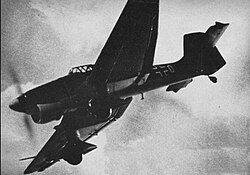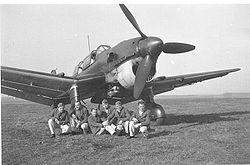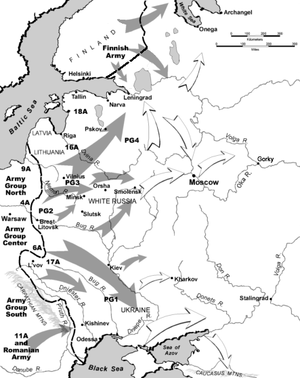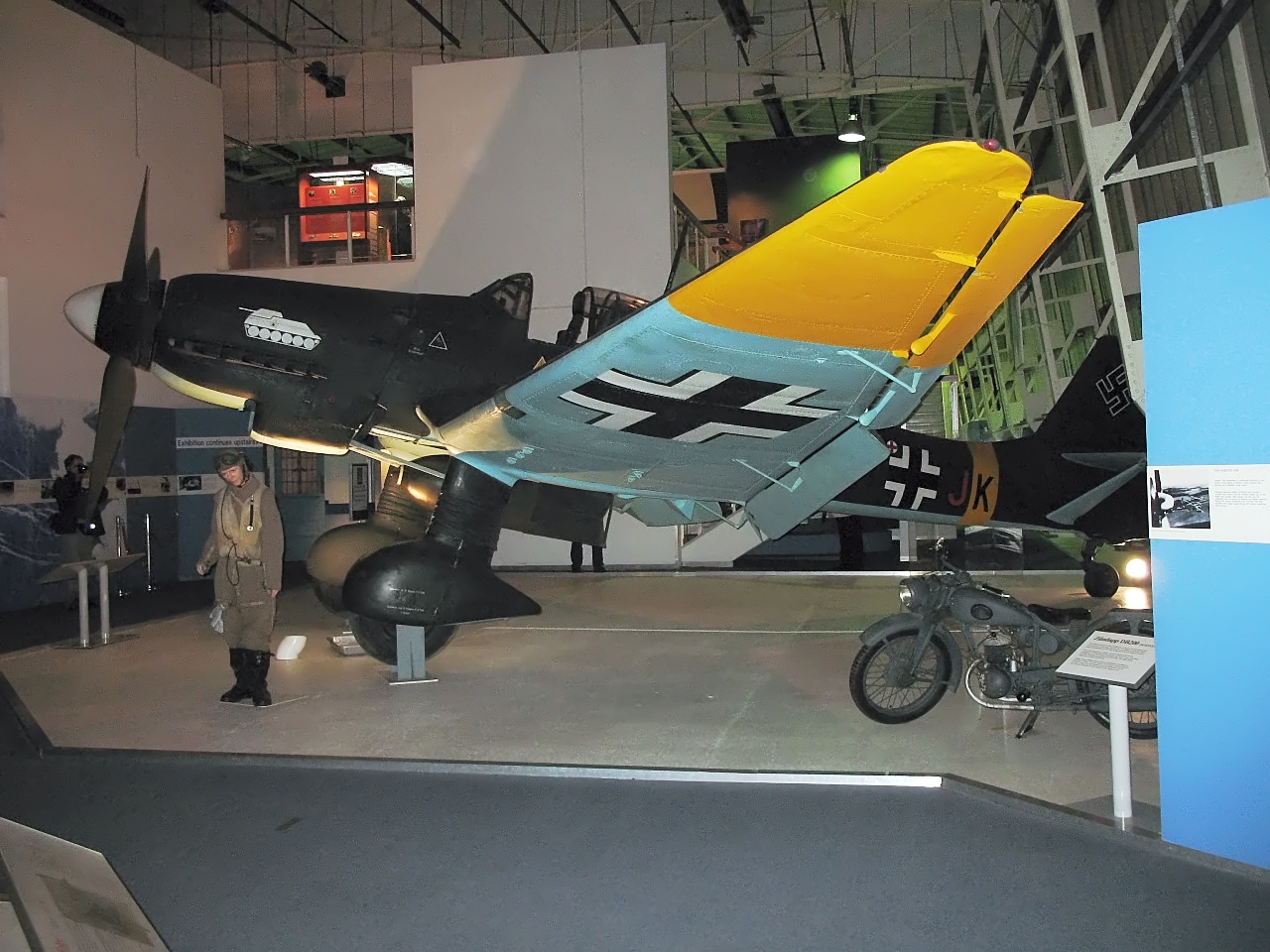Stuka (Part Two) 
The version B Stuka
Tests in Spain Up to 12 copies of different variants were tested in operational conditions by the Condor Legion during the English Civil War, probably the V4 prototype was first shipped in late 1936.
The VB/88 Groups, experimental unit of the Legion, received a total of six Ju 87A for evaluation in combat. Apparently used in action in breaking the Bilbao Iron Belt and Teruel, the "Anton" were replaced in the third quarter of 1938 by as many Ju 87B-1, which were used primarily for national progress on the Mediterranean coast and Catalonia. Stuka
All of VB/88 returned to Germany at the end of the Civil War, including the remains of a specimen shot down over Bujaraloz. In Spain, the Stuka proved to have excellent dive bomber, reaching an accuracy of less than five meters in point objectives. World War II
At the start of World War II, the Luftwaffe had 336 Ju 87B.
The first combat mission in WWII was made by three Ju 87B-1, which took off from Elbing at 4:26 am on 1 September 1939 to destroy the Polish blasting device Dirchau bridge over the River Vistula, which that met at 4:34 am, ie about 11 minutes before the declaration of war against Poland.
was widely used in the early German campaigns in Poland, France, in the invasion of Russia, North Africa and the Mediterranean, with good results especially in attacks on ships and mobile units. At the end of World War II, 5,709 units were built in several variants (this is the generally accepted figure), being used in almost all European and North African scenes.
was a plane stable, accurate and very effective, though its age was too slow, not very maneuverable, lightly armed and highly vulnerable to enemy fighter aircraft. The Germans learned at the Battle of Britain that air superiority must be obtained before embarking on a ground attack effectively, superiority which had always been in previous seasons.
The Stuka is always associated with the most decorated German soldier, Hans-Ulrich Rudel, Stuka pilot of an anti-tank version of Ju-87G-1.
variants and versions  Ju 87 A of the Italian Regia Aeronautica.
Ju 87 A of the Italian Regia Aeronautica. conjunction with the Ju 87B-2 variant, which as a car carrying a bomb could SC100, Weser built a lot of Ju 87C-0 with folding wings, tail hook and other changes to adapt it for use aboard the aircraft carrier Graf Zeppelin, which would never be finished. Another model was the long-range Ju 87R, with extra tanks in the outer section of the planes and equipment for underwing tanks droppable. Entered service in time for the campaign in Norway, where one of them crippled radio station deliberately colliding antennae, and was particularly appropriate in the theaters of operations in the Balkans, Greece and the Mediterranean. The Ju 87B experienced a large container suspended in the fork of the main pump for transporting spare parts and various loads.
The Ju 87B and its derivatives caused widespread devastation in Europe in the early years of World War II, where they found one serious obstacle. About England its losses were unacceptably high with 41 kills on days 13 to August 18, 1940, so from 19, the Stuka was withdrawn from the attacks on British targets.

Upon the outbreak of war the Ju 87 design could be considered somewhat dated, but that fact was hidden by his great success. As was the case with other types of the Luftwaffe, the lack of an effective substitute found the protracted nature of mass production and as the Messerschmitt Bf 110 and the Heinkel He 111, its production increased from 1941 to 1944. The standard base rate during that period was the Ju 87D, designed in 1940, first flown in early 1941 and used in combat on the Eastern Front and North Africa. It was powered by a Jumo 211 J-1 of 1,400 hp propeller moving RV-11 very wide blade, providing improved flight performance, translated into more offensive load. The maximum load reached 1,800 kg bombs, could lead the central support PC1400 piercing bomb of 1,400 kg, and the underwing paths SC500 or a wide range of cargo, including containers of six MG 81 machine guns of 7.92 mm or two 20 mm cannons. The rear defensive armament was replaced by a double mounting MG 81 Z, exceptionally light weapons a high rate of fire-powered tape instead of the combs of 75 shots. In addition, refined lines of the aircraft to reduce drag, the most notable improvement corresponded to the hood and roof of the cab. The landing gear was also redesigned, and from 1942 the wheel fairings and legs were gradually discarded.
The most numerous variant was the Ju 87D-3, incorporating greater protection for the crew and vital parts of the apparatus as a result of its increasing use as Schlachtflugzeug (air assault or close support). Since 1942 all versions began to carry out different missions of dive bombing, such as glider towing, attack on the partisan guerrillas and small transport a wide variety of loads. A few Ju 87D-4 were fitted as a torpedo, and the next major variant was the Ju 87D-5, with larger to counter the weight gain of the series Dora. The Ju 87D-7 was a night variant motivated by the heavy losses in daylight assault missions, Jumo 211P engine more powerful and long flame arrestor in the exhaust that was above the wing trailing edge. As in option D-8, fixed machine guns were replaced by MG 151 cannons of 20 mm and dive brakes disappeared. The Ju 87D-8 was the latest series, the total number of examples built in late September of 1944-when virtually ceased aircraft production, except for fighters, reached the generally accepted figure of 5,709.
There were plans for other successors, such as 87F and the Ju Ju 187, but only built conversions of the ubiquitous model D. The most important of these was the Ju 87G subtype, of which only became operational the Ju 87G-1. It was a specialized anti-tank version equipped with two cannons BK 3.7 (Flak 18) suspended under the wings right next to the landing gear. This 37 mm cannon was a formidable weapon, weighing 363 kg and had been widely used as anti-aircraft. However, the barrel had a serious drawback: despite the high velocity (850 m / s) of your piercing projectile, provided for only six rounds per gun metal comb, and a rate of fire of 160 rounds per minute, which meant a total duration of the burst 2.25 so of barely two shells per second.

Al
largest user of Ju 87G-1, Hans Ulrich Rudel, is credited with 519 Soviet armored vehicles destroyed. This pilot, lame in one leg, made 2,530 combat missions and remained in command of formations Stuka missions day, long after that the remaining vulnerable Stukagruppen aircraft had replaced their safer by Focke-Wulf Fw 190 F and G.
Another variant produced by conversion of existing cells of the Ju 87D was the double-seater coach Ju 87H command. Initially was not considered necessary for a coach Ju 87, but in 1943 the art of survival with such aircraft had become a very specialized and important task in the Eastern Front, that even veteran fighter and bomber pilots were very experienced to fly with instructors Ju 87 before taking their new posts in the decimated ranks of the Stukagruppen. In almost all variants existed conversions Dora H, which maintained the same number suffix.
There were some experimental variants, mainly dedicated to weapons testing of other aircraft. One of the most amazing test programs was that of a Ju 87D-3 cabins equipped with large fairing on the plans. The idea was to make the Ju 87 a vehicle for the infiltration of agents in the enemy's rear. The final design of the cockpit provides space for two men sitting in tandem, with large windows to provide the pilot with lateral vision, soft dive, the two gondolas were detached from the wings and descend by parachute. There is no evidence that the system was used.
The Ju 87 was widely used by all the air forces of the Axis, including Italy. Hungary, Slovakia, Romania and Bulgaria. Al discovery of a Ju 87 with Italian insignia mistakenly thought that was manufactured in Italy, Britain even came to invent the 201 Breda Picchiatelli designation. In fact, since 1939 all the Ju 87 were built in the same building Weser Tempelhof. General characteristics
(The list does not include the Ju 87C, naval adaptation derived from Ju 87B, created for use in German aircraft carrier Graf Zeppelin, and the Ju Ju 87E 87D naval derivative of, nor the long-range Ju 87R, nor Ju 87H disassembled for use in training and coaching)


• The Ju 87A could carry a bomb 500 kg without rear gunner and at short
• The Ju 87B could carry a 1,000 kg bomb but no rear gunner and at short
• The Ju 87D was carrying a heavy bomb only for short flights.
• The Ju 87D-5 could increase the scale to 15.00 m and replacing the two MG 17 MG 151/20 cannon to increase its ground attack capability. Continue


























